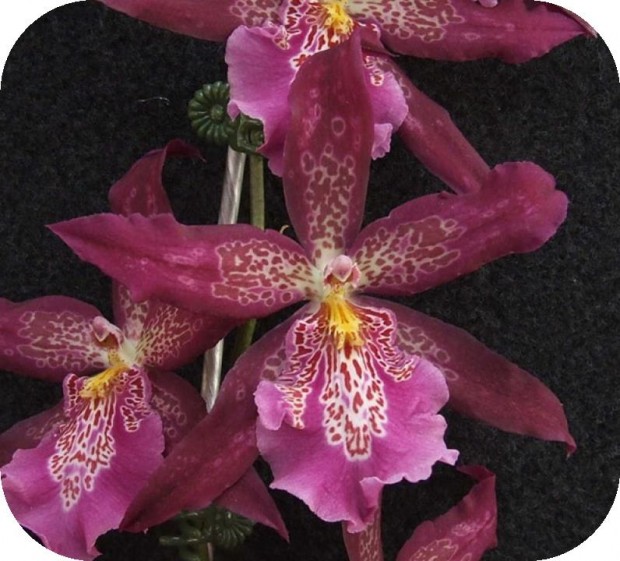Cultural Advice…..
Cultural Notes
Fertilizing Orchids ……..click to view document
Seasonal Tips …
SUMMER GROWING
DECEMBER-JANUARY-FEBRUARY
- These are the best growing months, the longest day-length of sun light and the warmest temperatures, night and day. Your plants should be growing at their best and it is up to you to supply them with the fertilizers and water they need to respond to these conditions.
- Water every 2/3 days with open type potting mixes, such as bark/charcoal/styrene foam.
- Water every 3/4 days with a more packed type mixes, such as sphagnum moss/peat moss/perlite/coconut chunks.
- Fertilize every week at half strength, a higher nitrogen content is recommended. (Urea is not recommended) There are many fertilizes available, try to keep in the following ranges N 15/20 P 4/8 K 8/14 plus trace elements.
- Calcium Nitrate at 1 gram to a litre fortnightly, any organic fertilizer can be used, Seasol, Nitrosol, Fish, Molasses etc.
- You have to allow for lengthy rain periods and overcast conditions at this time of year.
AUTUMN GROWING
MARCH – APRIL – MAY
- These months are the slowing down months. When the growth period of summer, changes over to the start of the flowering period and the preparation for the coming of winter.
- You need to start changing your fertiliser, from the higher Nitrogen type, to the higher Potash/Potassium. This changeover is done during the month of March. Remember the equinox is on the 22nd March. (Equal hours of day and night). I start mixing the two types of fertilisers on the 1st March, decreasing the high nitrogen type and slowing increasing the high potash/potassium, 50% of each is reached about the 15th March. Full change over occurs by the end of March.
- Your watering program will become longer between waters, 2/3 days at the beginning of March, to 4/5 days at the end of May.
- Fertilising is now every second watering ( starting at 4/6 days extending to 8/10 days) at half strength. DON’T FORGET THE SEASOL for the coming winter, use at normal strength. Try to keep the fertilisers within the following ranges: N 8/10 P 8/12; K14/16. Plus trace elements.
WINTER GROWING
JUNE – JULY – AUGUST
- Wind protection on the southern and western walls to keep the cold winds out. This is minimum, some growers put plastic on all four walls.
- Water in the mornings, before 9am, on clear sunny days, allows them to dry out.
- Water plants every 4 days at the start and end of winter, every 6 to 7 days in mid-winter.
- Watch the weather charts for very cold or wet days, you may have to adjust your watering program.
- Do not fertilize heavily in the winter. Use low nitrogen type fertilizers, every 14 days at half strength.
- I like Seasol as it helps the plant to be less stressed with the cold weather. It is the best anti-freeze product available and the cheapest. University of Tasmania Tests.
- Use Seasol every 12 to 14 days throughout the winter to maintain cold weather protection, it will also return plant back to normal growth.
- Mix at 2mls to a litre.
- Most hybrids orchids grow during the whole year. Species do not.
- Remember that during the winter the sun shines less, so the plants grow slower, you cannot force them to grow quicker, unless you go to a lot of expense with lighting, heat etc.
SPRING GROWING
SEPTEMBER – OCTOBER – NOVEMBER
- These months are the start of the growing season, the orchids have just come through the winter and as the days lengthen and get warmer, the plants are on the move, with their eyes and roots starting to grow.
- You need to start changing your fertiliser, from the higher Potash/Potassium, to a higher Nitrogen type. The change-over is done in the month of September, with the equinox on the 22nd September. (Equal hours of day and night).
- Rotating the two fertilisers (high potash /Potassium to the high Nitrogen type) decreasing the first and increasing the second so that the change-over has taken place by the end of September. (50% of each by 15th Sept.)
- Your watering program will become more frequent, starting at 3 to 4 days September to 2 to 3 days at the end of November.
- Fertilise every second watering at half strength; try to keep the N.P.K within the following ranges. N15/20—P 4/ 8—K 8/14 with trace elements. Use organic fertilisers too, rotate your fertilisers as each has different and varying ingredients and this helps to cover all the nutrients needed.
51,002 total views, 3 views today

